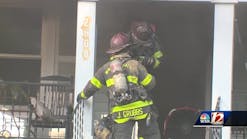Throughout the United States, engineered wooden I-beam joists are becoming more prevalent in residential construction for several reasons. For example, they can be more cost effective than dimensional lumber, especially in longer lengths; they can span longer distances without vertical supports; spacing can be wider on center, thus reducing material; they are lighter and easier to handle; and they are straighter, with no crowning.
That's all fine for the builder and for the homeowner, who can take pride in reduced lumber consumption and the ecological friendly nature of engineered wood. But what about the life safety of firefighters? How will lightweight structural support beams hold up when exposed to heat and flame?
In my 31-plus years in the fire service, I never once was concerned about the structural integrity of a floor I was operating on, whether advancing a hoseline into an inferno or conducting a initial primary search under a heavy smoke condition. Every residential floor was comprised of solid dimensional lumber. The structural stability of such a solid-mass floor enabled firefighters to accomplish all phases of structural firefighting: primary, secondary and tertiary searches; occupant rescue and removal; fire suppression; defining fire travel and extension; overhauling and salvage; and protection from secondary fire damage. Time and time again, the same routine interior attack strategy and tactics were implemented for occupied residential occupancies. This planned and coordinated attack could vary, dependent upon the type of occupancy and the severity of the fire.
Time is not on our side. A floor system constructed with these engineered products can collapse within minutes after exposure. Lightweight construction presents two major concerns: very fast-moving, very hot fires, especially when vinyl exterior siding is involved; and the rapid collapse of the floor and roof when fire and or heat impinges on the trusses or wooden I-beam joists.
The following information is provided by the National Institute of Standards and Technology (NIST): "Predicting a potential structure collapse is one of the most challenging tasks facing an incident commander at a fire scene. Usually, lack of information on the construction of the building, fire size, fire location, fire burn time, condition of the building, fuel load and floor weight load make the task nearly impossible. Many factors influence the failure of structural elements -- the floor load, fire intensity, fire duration, fire-resistance rating of wood assembly consisting of wood I-beams or wood trusses protected by half-inch gypsum board (20-minute rating), the fire resistance and ability of a structural member to maintain its load during an actual fire."
Today, the fire service is faced with a new life-threatening dilemma, the collapse potential and the structural stability of engineered structural elements when exposed to heat and fire. In four recent fires in four states, the lives of five firefighters were lost in residential fires due to structural floor collapse. The common thread in these incidents was the fire location, which originated in the basement area, lightweight residential construction, type of floor system which comprised of wooden I-beams used as floor joists and open-web gang plate floor trusses. There was no fire-rated thermal barrier to the underside of the unprotected engineered I-beam joists or the open-gang plate floor trusses.
The following information is from a recent National Institute for Occupational Safety and Health (NIOSH) firefighter fatality investigation report: "Tests conducted by the Illinois Fire Service Institute at the University of Illinois suggested that engineered wooden I-beams can fail in as little as four minutes and 40 seconds under controlled conditions." While objective time-to-failure studies of various lightweight flooring systems being used today have been conducted only in limited cases, evidence from two investigations suggest and seem to support the fact that engineered I joists quickly lose strength and integrity when damage and weakened by heat exposure and flame impingement. The weakened floor joist can be difficult to detect from above, as the floor surface may still appear intact.
Other tests conducted in California on wooden I-beam joists recorded a failure time of three minutes 20 seconds. Tests of wooden gang plate open-web parallel cord trusses found failure times from one minute and 20 seconds to 10 minutes. That means that the floor can be in the collapse mode prior to arrival, just waiting for the additional weight of a firefighter. The weakened floor joist can be difficult to detect from above, as the floor surface may still appear intact.
Firefighters who operate on floors above fire-damaged engineered I-joists may fall through the weakened floor and become trapped in the fire below. This scenario is similar to walking on thin ice. The days of charging into a burning building have to be curtailed. A thorough 360-degree size-up must be performed before committing an attack. Ask yourself these simple questions: What is the type of floor and/or roof system? What is the fire intensity and location? What is the floor load? Are the structural elements protected with a thermal barrier? What is the fire duration before and after arrival? If the answer to any of these questions is "I don't know," then the answer is simple -- the structural elements of this lightweight construction fire building could be compromised. The rules have changed, so the fire service has to adapt. That's the bottom line.
What operational strategy should be implemented for lightweight construction? How will our tactics vary to provide firefighters with a safe operation? Consider these points:
- Improved building codes. First of all, we must enforce strict building code amendments. The best protection is a mandatory sprinkler system. Engineered wood I-joists, open-gang plate trusses, trusses without gussets or and other kinds of lightweight engineered floor beams, girders and dimensional lumber must be protected with a minimum of a one-hour rating. The FDNY uses a critical information dispatch system (CIDS) to relay pertinent information using the address for that particular building. Lightweight construction, a peculiar layout or other vital information is communicated to responding units prior to arrival. This information is also transmitted from the dispatcher upon request.
- Pre-planning. A pre-plan of all new and existing structures, whether residential and or commercial. This pre-plan must include an operational plan for firefighters to follow, no exceptions. Today, firefighters must consider the risk analysis -- it's your life versus collapse and entanglement. We must implement a cautious, planned, coordinated attack, if feasible. The National Fire Protection Association (NFPA) 1710 standard states that a 2,000-square-foot, two-story house with a basement requires a minimum complement of 17 firefighters to operate at a structural fire.
- Initial information. Knowing the type of construction, whether charged hoselines are in readiness, whether a reliable and sufficient water supply is available, the location and severity of the fire, the amount of time the structure fire has been burning before and after arrival, and a thorough size-up when arriving on the scene. Just because the fire is venting out of windows on the first floor does not mean that is the fire's origin. The fire could have started in the basement or cellar fire below and is extending to the first floor. That also could mean that the floor can be in the collapse mode, just waiting for the additional weight of a firefighter.
- The floor load. Joe Homeowner decides to install a 135-gallon aquarium. The water weighs over 1,100 pounds, so add to that the weight of the tank and various rocks and 200 pounds of gravel. This weight is concentrated on two or three floor beam joists. Let's add a 54-inch wide-screen TV, a sectional sofa, a pressboard laminate wall unit, and various end tables and lamps over a ceramic-tile floor. How much weight do you think is on that floor area? A good guess is about 1½ tons.
I would like to hear from the field if your department has had any fires in lightweight construction that resulted in serious injuries as the result of a floor, ceiling or roof collapse or other unusual event. Please e-mail me at [email protected].
JOSEPH T. BERRY served for 31 years with the FDNY, where he worked as a firefighter in Ladder Company 24 in midtown Manhattan before he was promoted to lieutenant and worked in the South Bronx in Engine Company 73 and Ladder Company 42. He worked on the Ladders 3 Bulletin: Firefighting Tactics Procedures in Tenements and Ladders 5 Bulletin: Private Dwellings and Brownstone Buildings. Berry served as a member of the Division 6 Safety Committee and on five line-of-duty death investigation committees. He also worked on the department's lightweight residential construction and probationary firefighters manuals.





